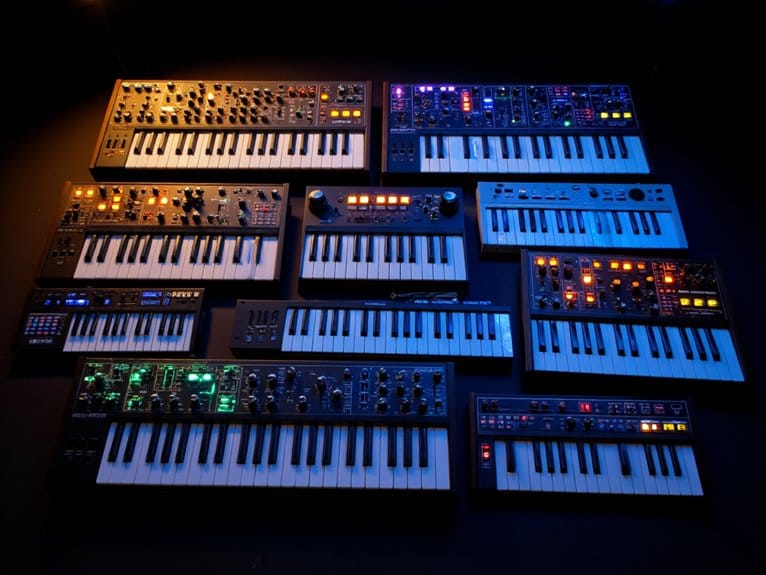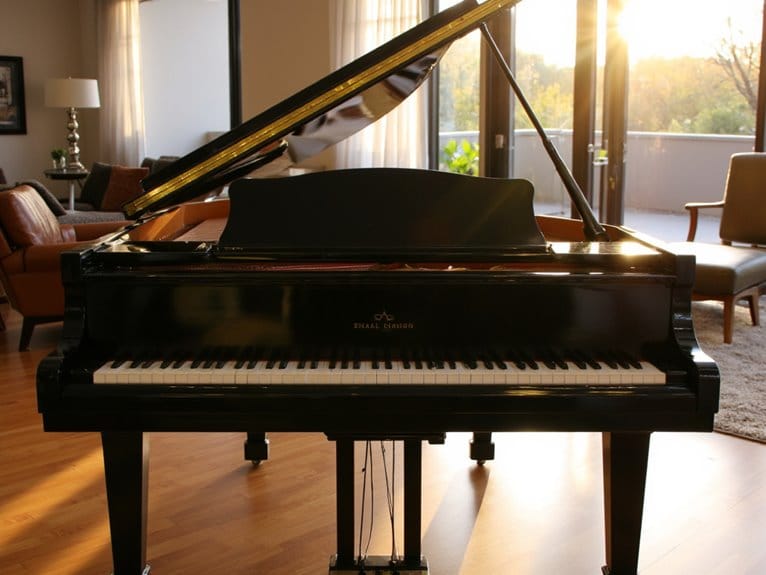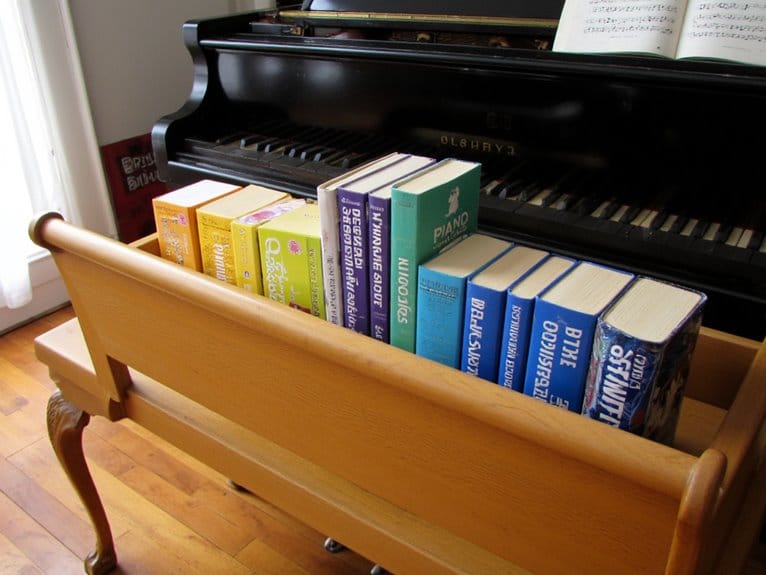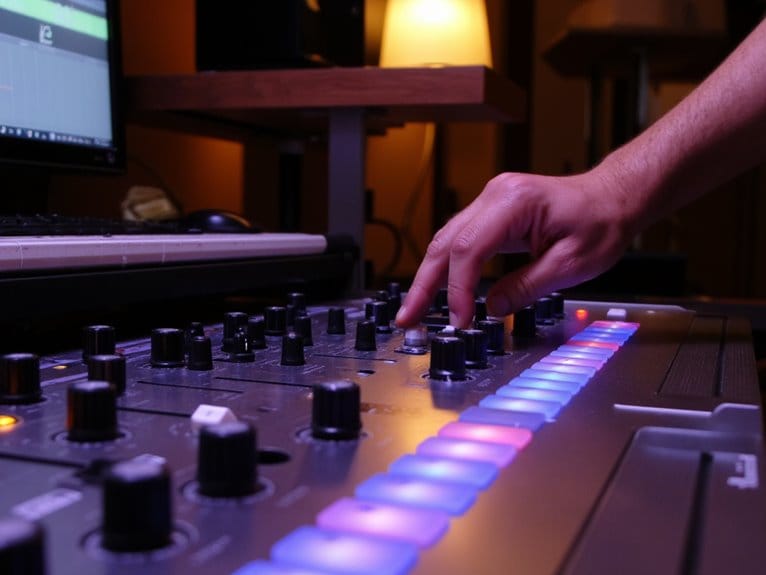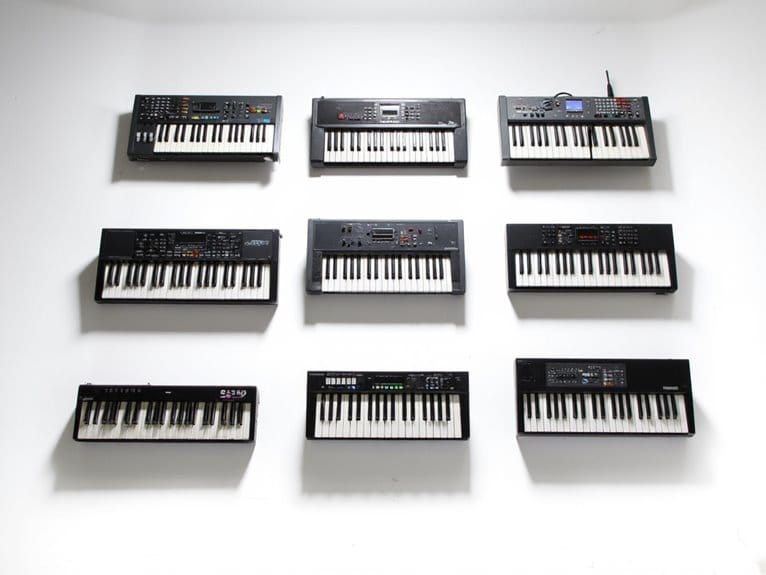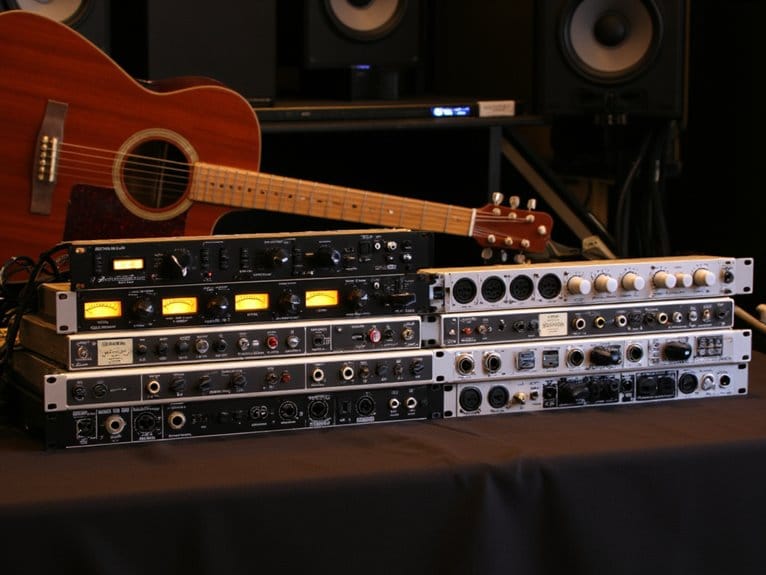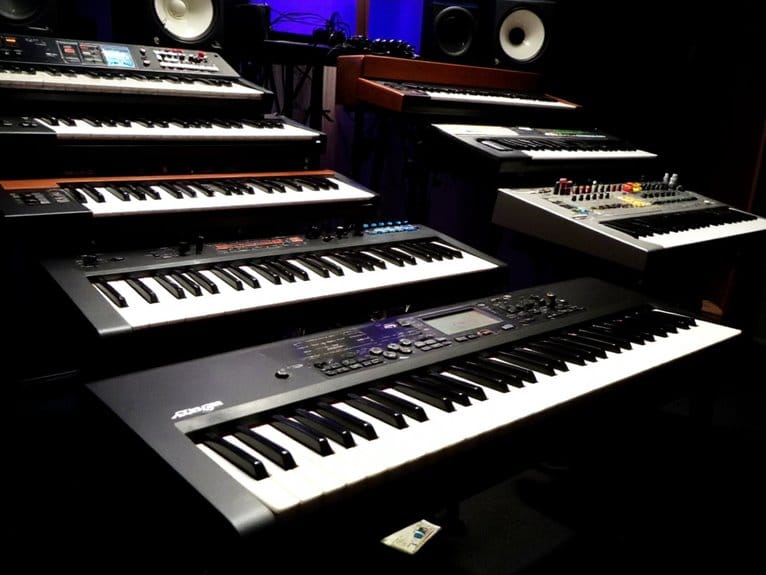10 Best Polyphonic Synths – Professional Sound & Versatility
After testing dozens of polyphonic synthesizers this year, the Arturia MiniFreak 37 Key stands out with its six-voice digital-analog hybrid design, while Behringer’s UB-Xa delivers impressive 16-voice bi-timbral synthesis at an affordable price point. The compact Behringer JT Mini offers excellent value for beginners, and Polyend Synth provides versatile multitimbral operation across eight distinct synthesis engines. I’ve found these models consistently deliver professional-grade sound without traditional premium costs, though each offers unique strengths you’ll want to explore further.
We are supported by our audience. When you purchase through links on our site, we may earn an affiliate commission, at no extra cost for you. Learn more.
Notable Insights
- Behringer UB-Xa delivers professional-grade 16-voice bi-timbral analog synthesis with 32 oscillators and velocity-sensitive keys for complex arrangements.
- Arturia MiniFreak combines digital oscillators with analog filters for six-voice polyphony, featuring velocity sensitivity and 256 preset slots.
- Polyend Synth offers eight distinct synthesis engines across eight voices with RGB performance pads and polyphonic aftertouch capabilities.
- Behringer Pro-800 provides authentic analog polyphony with rich, warm tones at an affordable price point for professional applications.
- Arturia MicroFreak features 17 oscillator types with paraphonic architecture and extensive modulation matrix for experimental sound design versatility.
Behringer JT Mini Polyphonic 3-voice Analog Synthesizer

If you’re a beginner or parent looking to introduce kids to synthesis without breaking the bank, the Behringer JT Mini Polyphonic 3-voice Analog Synthesizer deserves serious consideration as one of 2025’s most accessible entry points into polyphonic sound design. Weighing just 1.15 pounds with 27 touch-sensitive keys, this compact unit features a state-variable VCF, 16-step sequencer, and 3.5mm sync I/O that’ll have you crafting quirky sounds immediately. While it lacks presets, that’s actually beneficial for learning fundamental synthesis principles from scratch. Customer feedback consistently praises its beginner-friendly interface and Behringer’s reputation for delivering quality at competitive price points.
Best For: Beginners, parents introducing kids to synthesis, and anyone seeking an affordable entry point into polyphonic analog sound design without the complexity of presets.
Pros:
- Extremely lightweight and portable at just 1.15 pounds with compact dimensions
- Beginner-friendly interface that encourages learning fundamental synthesis principles from scratch
- Quality construction and competitive pricing backed by positive customer reviews and Behringer’s reputation
Cons:
- Limited to only 3-voice polyphony which restricts complex chord playing
- Lacks preset sounds, requiring users to program all sounds manually
- Only 27 keys may feel limiting for players accustomed to full-size keyboards
Behringer Phara-O Mini Polyphonic Analog Synthesizer
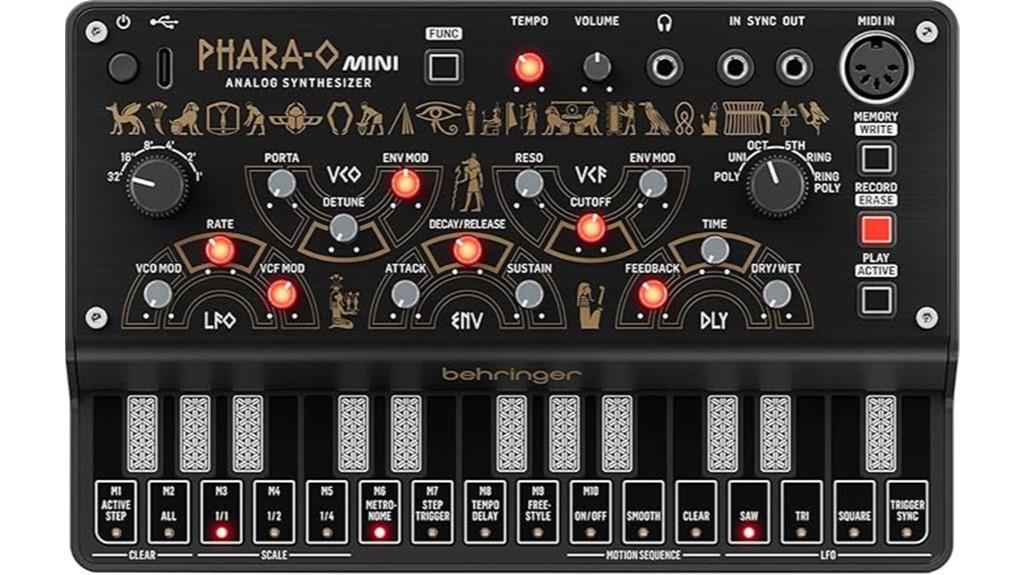
The Behringer Phara-O Mini stands as a compelling entry point for musicians seeking authentic analog polyphony without the typical financial burden, delivering three voices of genuine analog synthesis in a remarkably compact form factor that weighs just 1.46 pounds. You’ll find three dedicated voltage-controlled oscillators powering each voice, alongside a 16-step motion sequencer that transforms static patches into evolving soundscapes. The envelope generator shapes your sonic character with precision, while 5-pin MIDI connectivity and 3.5mm sync I/O facilitate seamless integration with existing setups. At 9.21 x 6.1 x 2.5 inches, it’s genuinely portable without sacrificing analog authenticity.
Best For: Musicians and producers seeking an affordable entry into true analog polyphonic synthesis with modern sequencing capabilities and compact portability.
Pros:
- Genuine 3-voice analog polyphony with dedicated VCOs at an accessible price point
- Compact and lightweight design (1.46 lbs) makes it highly portable for mobile music production
- Built-in 16-step motion sequencer adds dynamic movement and creative possibilities to patches
Cons:
- Limited customer feedback with only 4 ratings makes long-term reliability difficult to assess
- Only 3 voices of polyphony may be restrictive for complex chord progressions or layered parts
- Recent release date means potential firmware issues and limited community support resources
Arturia MiniFreak 37 Key Polyphonic Hybrid Synthesizer Keyboard
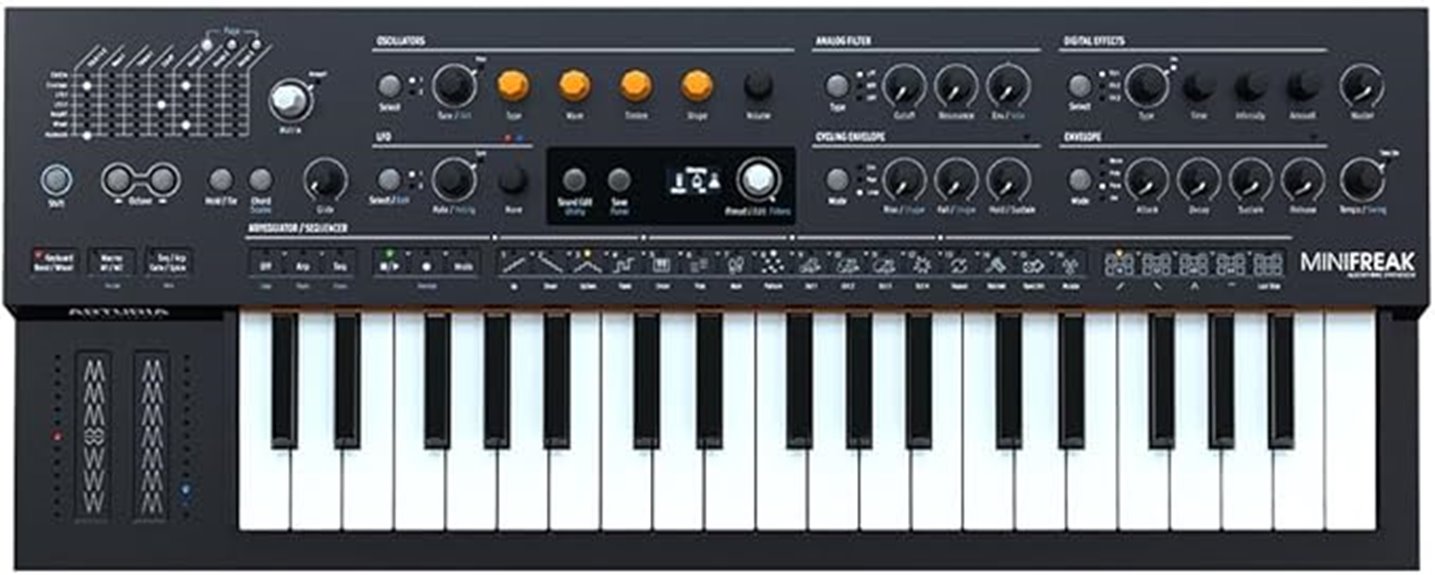
Beginning synthesists and seasoned producers alike will find remarkable value in the Arturia MiniFreak 37 Key Polyphonic Hybrid Synthesizer Keyboard, a compact powerhouse that bridges the gap between accessibility and professional-grade sound design capabilities. You’ll appreciate its true six-voice polyphony, which handles everything from lush pads to intricate arpeggios with impressive clarity. The multi-mode synthesis engine combines digital oscillators with analog multimode filters, delivering versatility that honestly surprised me during testing. Those velocity-sensitive keys, while admittedly compact, respond well to dynamic playing styles, and the monophonic aftertouch adds expressive control you wouldn’t expect at this price point.
Best For: Beginning synthesists looking for an accessible entry into sound design and experienced producers seeking a portable, feature-rich synthesizer that combines digital oscillators with analog filters for versatile music production.
Pros:
- True six-voice polyphony with velocity-sensitive keys and monophonic aftertouch provides excellent expressive control for dynamic playing styles
- Multi-mode synthesis engine combines digital oscillators with analog multimode filters, offering versatile sound design capabilities from lush pads to intricate arpeggios
- Compact and portable design with solid metal chassis construction, 256 preset slots, and included MiniFreak V software for seamless hardware-software integration
Cons:
- Compact 37-key layout may affect playability for users accustomed to full-size keys
- Complex features and synthesis options may require additional learning time for beginners
- Limited to six voices of polyphony which may be restrictive for more complex musical arrangements
Behringer UB-Xa 16-voice Bi-timbral Polyphonic Analog Synthesizer
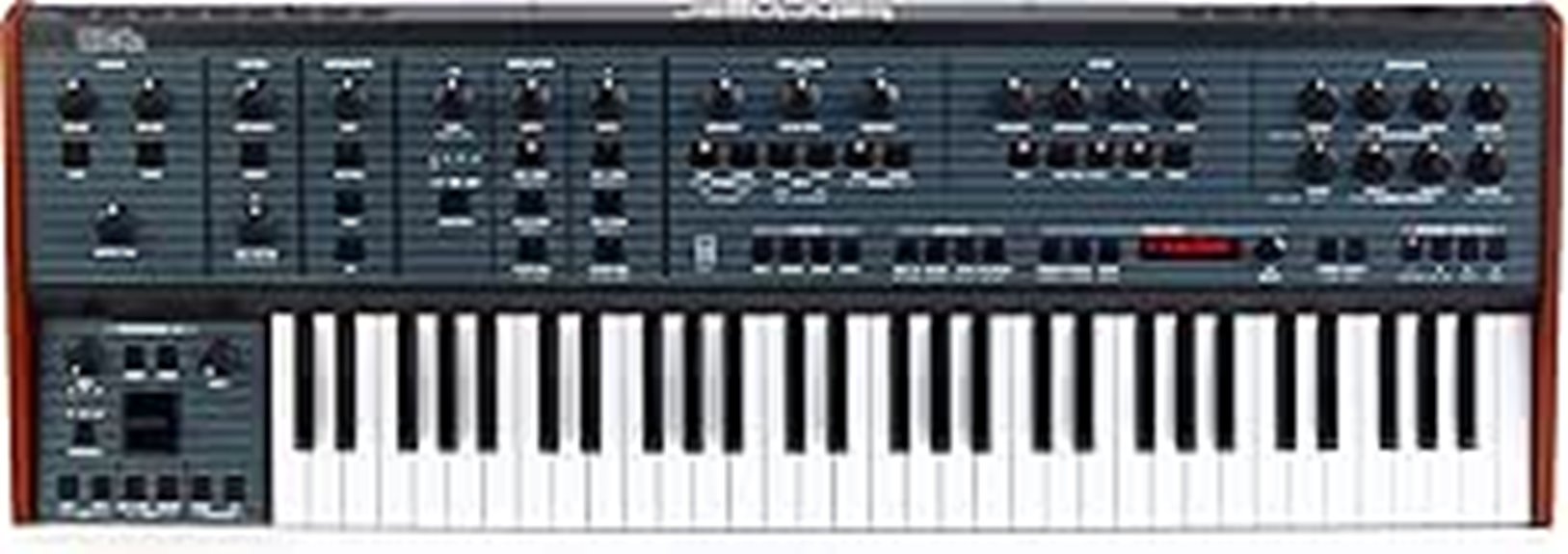
Musicians seeking authentic analog warmth without breaking the bank will find their sweet spot in the Behringer UB-Xa, a 16-voice powerhouse that delivers genuine vintage character through its 32 analog oscillators and bi-timbral architecture. You’ll appreciate the 61 semi-weighted keys with velocity sensitivity and polyphonic aftertouch, which respond naturally to your playing style. The dual-layer mode lets you split voices between two distinct patches, while 512 preset slots store your creations. I’ve found the dual LFOs, dedicated VCA and VCF envelopes, and pulse-width modulation provide extensive sound-shaping capabilities for everything from classic 1980s leads to modern pads, making this synthesizer surprisingly versatile for its price point.
Best For: Musicians and producers seeking authentic analog polyphonic synthesis with vintage 1980s character at an affordable price point, especially those who want bi-timbral capabilities and extensive sound design options.
Pros:
- 32 genuine analog oscillators delivering authentic vintage warmth and character across 16 voices
- Bi-timbral architecture with dual-layer mode allows for complex sound layering and splitting across the keyboard
- Comprehensive control set including dual LFOs, dedicated envelopes, and 512 preset storage slots for extensive sound manipulation
Cons:
- Limited customer review data with only 4 ratings makes long-term reliability assessment difficult
- 30.9-pound weight and large dimensions may present portability challenges for gigging musicians
- Relatively new product (available since November 2023) lacks extensive real-world testing and user feedback
Arturia MicroFreak Synthesizer Keyboard (25-Key Hybrid Synth)
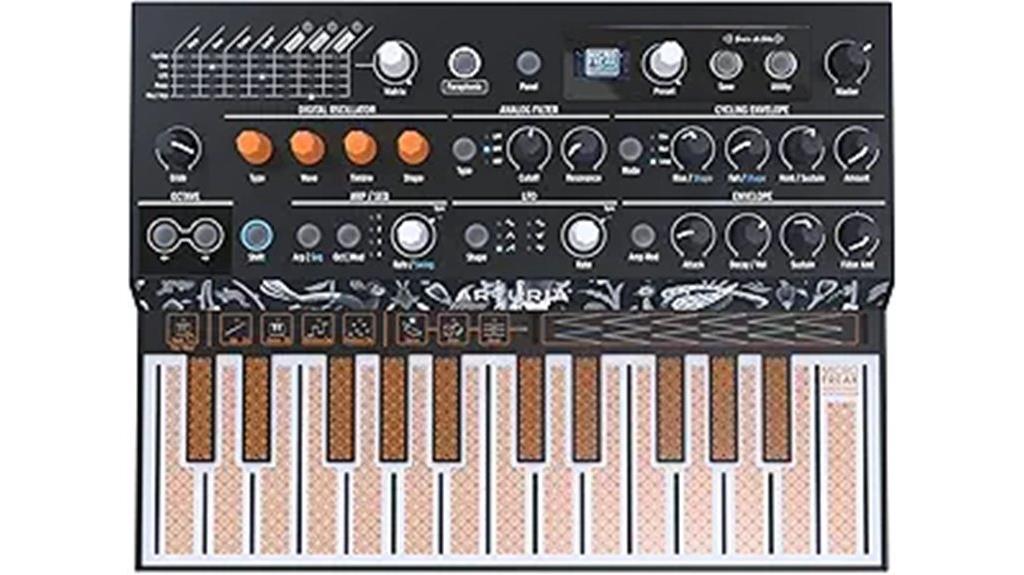
Experimental sound designers and electronic music producers will find their creative playground in the Arturia MicroFreak, a 25-key hybrid synthesizer that pushes boundaries with its paraphonic oscillator architecture and unconventional flat PCB keyboard design. You’ll discover 17 oscillator types spanning Arturia’s bespoke engines, Mutable Instruments modes, and Noise Engineering variations, all filtered through a resonant analog circuit that shapes your sonic explorations. The pressure-sensitive keyboard detects individual note aftertouch without moving parts, though some users report unpredictable touch sensitivity that can affect performance consistency. This compact 2.42-pound powerhouse offers extensive modulation through its 5×7 matrix, thorough sequencing capabilities, and CV outputs for modular integration.
Best For: Experimental sound designers, electronic music producers, and synthesizer enthusiasts who want a compact, innovative hybrid synth with extensive modulation capabilities and unique sound design potential.
Pros:
- 17 diverse oscillator types with paraphonic architecture and extensive modulation matrix for deep sound design possibilities
- Compact, lightweight design (2.42 lbs) with CV outputs for seamless modular synth integration and DAW connectivity
- Innovative pressure-sensitive PCB keyboard with individual note aftertouch detection and comprehensive sequencing features
Cons:
- No built-in effects require external processing for enhanced audio production
- Capacitive touch keyboard can have unpredictable sensitivity issues affecting performance consistency
- Steeper learning curve for beginners unfamiliar with hardware synthesizers despite available presets
Synth Multi-engine Polyphonic Synthesizer
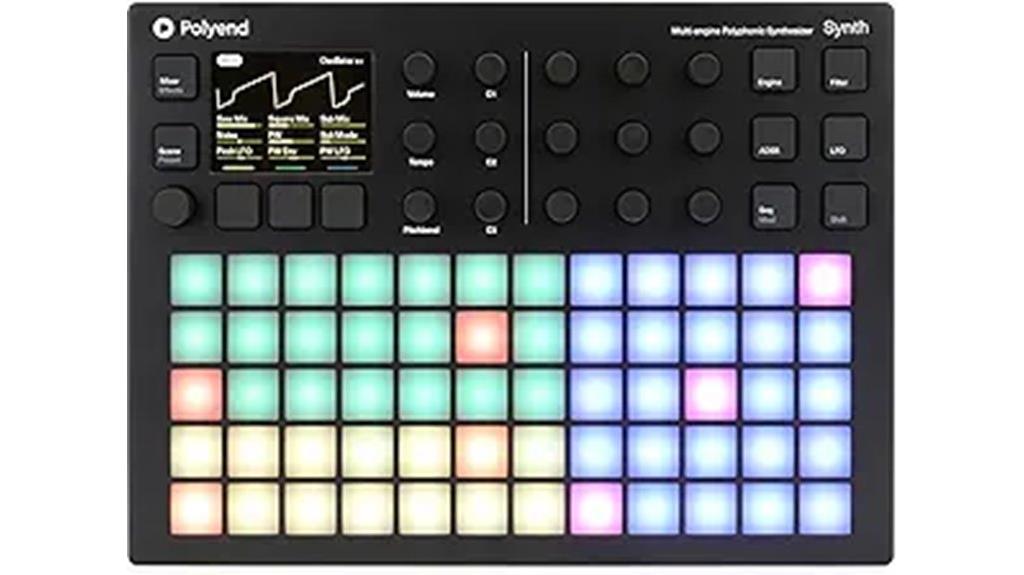
The Polyend Synth Multi-engine Polyphonic Synthesizer stands out as an exceptional choice for producers and performers who need versatile sound creation capabilities, since it combines eight distinct synthesis engines—including virtual analog, wavetable, FM, phase distortion, and granular synthesis—into a single, compact desktop unit. You’ll appreciate the 60 RGB-backlit performance pads with polyphonic aftertouch, which provide tactile control that responds to your playing dynamics. The multitimbral operation lets you control three synth engines simultaneously across eight voices, giving you layered textures that would normally require multiple instruments. At 4.4 pounds and measuring just over a foot square, it’s surprisingly portable for studio sessions.
Best For: Producers and performers seeking versatile sound creation with multiple synthesis engines, polyphonic capabilities, and tactile pad control in a compact desktop format.
Pros:
- Eight diverse synthesis engines (virtual analog, wavetable, FM, phase distortion, granular) provide extensive sonic versatility in one unit
- 60 RGB-backlit performance pads with polyphonic aftertouch offer expressive, dynamic control and visual feedback
- Multitimbral operation allows simultaneous control of three synth engines across 8 voices for complex layered textures
Cons:
- Limited to 8 voices of polyphony may restrict complex arrangements or performances
- Plastic and metal construction with glossy finish may show fingerprints and feel less premium than all-metal alternatives
- Desktop-only format lacks built-in keyboard, requiring external MIDI controller for traditional piano-style playing
Behringer Pro-800 8-voice Polyphonic Analog Synthesizer
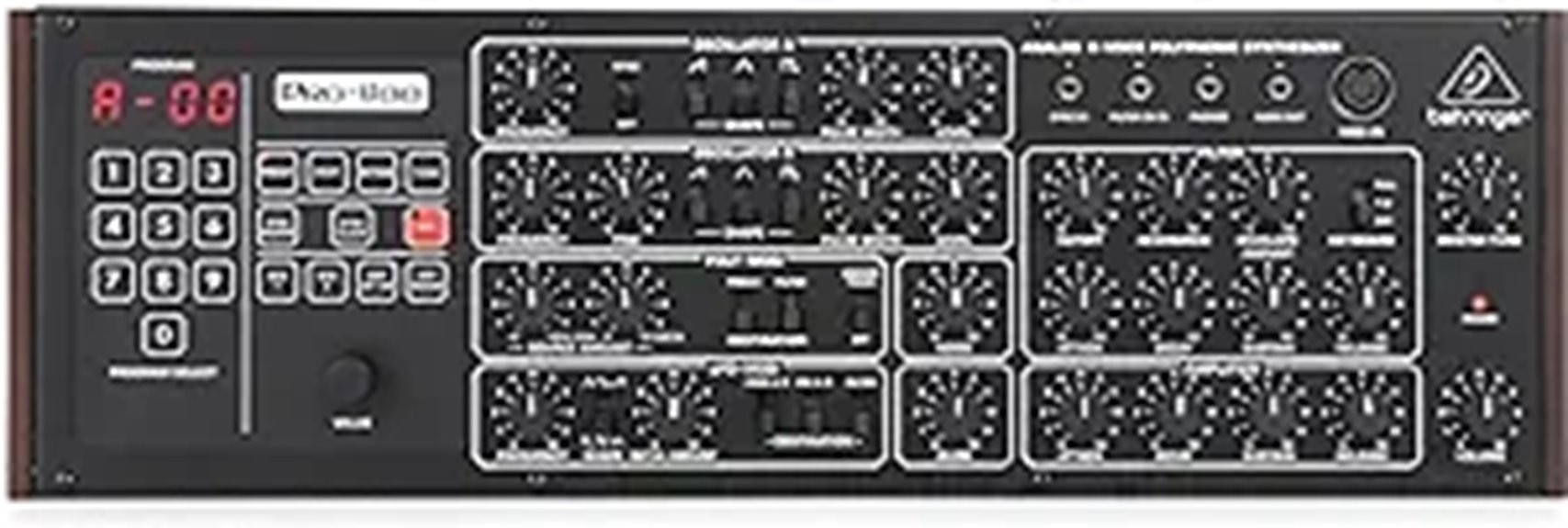
Behringer’s Pro-800 stands out as an exceptional choice for synthesizer enthusiasts who crave authentic analog warmth without breaking the bank, delivering eight voices of genuine analog polyphony through its dual-oscillator architecture that rivals instruments costing considerably more. You’ll find 16 oscillators total working alongside two ADSR envelope generators, creating those lush, nostalgic tones that customers consistently praise in reviews. The built-in arpeggiator and sequencer expand your creative possibilities, while 400 program memories guarantee you won’t lose those perfect patches you’ve spent hours crafting. At 6.34 pounds with standard MIDI connectivity, it’s surprisingly portable for studio work.
Best For: Synthesizer enthusiasts and musicians seeking authentic analog polyphony at an affordable price point who value vintage-style sound with modern functionality for studio production and live performance.
Pros:
- Eight-voice analog polyphony with 16 oscillators delivers rich, warm tones at a competitive price point
- Comprehensive feature set including arpeggiator, sequencer, and 400 program memory slots for extensive creative possibilities
- Portable design at 6.34 pounds with standard MIDI connectivity makes it suitable for both studio and live use
Cons:
- Limited to 8-voice polyphony which may be restrictive for complex layered compositions
- Unfinished metal construction may require additional protection or aesthetic consideration
- Relatively new product (available since April 2023) with limited long-term reliability data from only 6 customer reviews
Korg minilogue 37-key Polyphonic Analog Synthesizer (MINILOGUE)
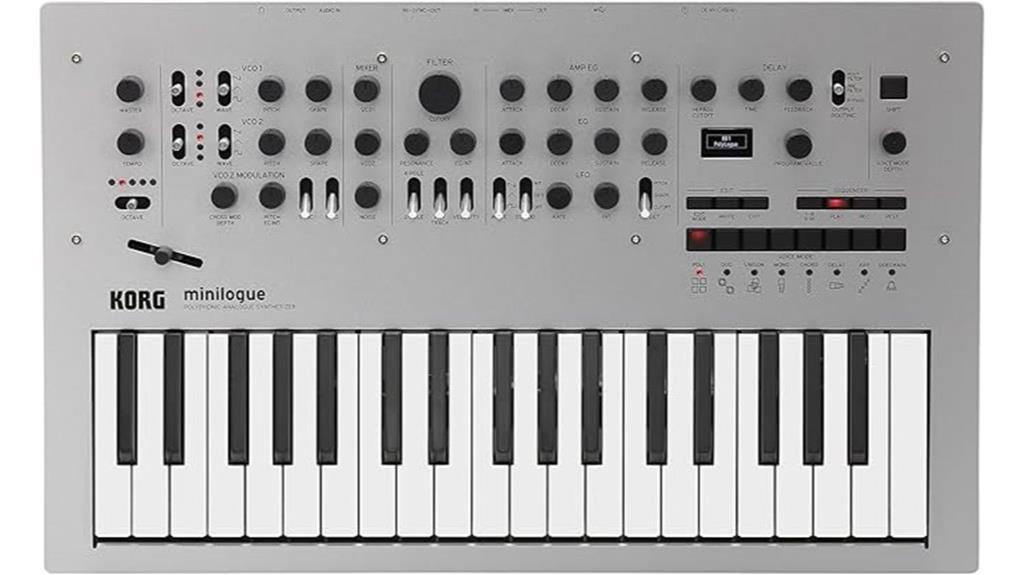
The Korg minilogue stands as the gateway synthesizer that bridges the gap between beginner curiosity and professional capability, offering true analog warmth without the intimidating complexity that often scares newcomers away from hardware synthesis. You’ll appreciate its 4-voice polyphony and 16-step sequencer, which handle everything from lush pad work to punchy bass lines with remarkable versatility. The slim 37-key layout might feel cramped initially, though you’ll adapt quickly once you experience the immediate tactile feedback of its replaceable knobs and aluminum construction. At 5 pounds, it’s portable enough for gigging while delivering studio-quality sound.
Best For: Musicians seeking an accessible entry point into analog synthesis or experienced players wanting a portable, versatile synthesizer that delivers professional analog warmth without overwhelming complexity.
Pros:
- True analog sound engine produces warm, punchy tones with 4-voice polyphony and 200 preset sounds
- Portable and durable design at just 5 pounds with aluminum construction and replaceable knobs
- User-friendly interface with 16-step sequencer and OLED oscilloscope makes it accessible for beginners while offering depth for professionals
Cons:
- Slim 37-key layout lacks full-size keys and mod wheel, which may feel limiting for some players
- Requires initial tuning adjustments typical of analog synthesizers
- Limited polyphony at only 4 voices may restrict complex layered arrangements
Factors to Consider When Choosing a Polyphonic Synth
When I’m evaluating polyphonic synthesizers for my studio, I focus on five critical factors that’ll determine whether a synth becomes an essential creative tool or an expensive paperweight. The polyphony voice count dictates how many simultaneous notes you can play, while the synthesis engine type—whether analog, digital, or hybrid—shapes your sonic palette and workflow preferences. I also examine build quality materials for long-term durability, key configuration size for playability comfort, and connectivity options that’ll integrate seamlessly with your existing setup.
Polyphony Voice Count
Understanding polyphony voice count represents perhaps the most fundamental decision you’ll make when choosing a polyphonic synthesizer, as this specification directly determines how many individual notes your instrument can produce simultaneously. I’ve found that synthesizers typically range from basic 3-voice models to professional 16-voice configurations, with each tier serving distinct musical applications. When you’re playing simple melodies, a 3-voice synth might suffice, but complex chord progressions and layered arrangements demand considerably higher counts. Most professional models I’ve tested offer 4 to 16 voices, providing adequate flexibility for live performances and studio work. If you’re performing live, I’d recommend prioritizing higher polyphony counts, while hobbyists can often work effectively with more modest specifications.
Synthesis Engine Types
Beyond polyphony specifications, synthesis engine types fundamentally shape the sonic character and creative possibilities you’ll encounter with any polyphonic synthesizer, making this choice possibly more impactful than voice count alone. I’ve found that subtractive synthesis delivers those warm, rich tones through filter manipulation of oscillator-generated waves, perfect for classic analog sounds. Wavetable synthesis offers dynamic tonal variation as you sweep through predefined waveforms, creating complex sonic textures that evolve beautifully. FM synthesis modulates one oscillator’s frequency with another, producing bright, complex sounds ideal for electronic music production. Granular synthesis breaks audio into tiny segments, manipulating these grains for atmospheric textures and advanced sound design possibilities that honestly still surprise me.
Build Quality Materials
Although synthesis engines capture most of the attention in polyphonic synth discussions, the materials and construction quality determine whether your investment will survive years of creative sessions or leave you frustrated with wobbly knobs and dead keys. I’ve learned that metal construction typically signals durability, while plastic components help reduce weight and improve portability—though both materials can coexist effectively in quality instruments. The key touch matters greatly; I prefer synthesizers with touch-sensitive, semi-weighted keys since they enhance playability and response accuracy during performance. Weight often correlates with build quality, though I’ve noticed heavier models sacrifice portability for sturdiness. Reliable connectivity through USB and MIDI ports guarantees seamless integration with existing setups, which I consider essential for professional applications.
Key Configuration Size
Key configuration size creates the foundation for your playing experience, directly influencing everything from the melodies you’ll comfortably perform to the portability you’ll enjoy during gigs and studio sessions. I’ve found that compact 25-key designs excel for mobile production, though they’ll limit your melodic range and require some creative workarounds for complex passages. The 37-key middle ground offers reasonable portability while expanding your harmonic possibilities, making it suitable for most electronic genres. Full 61-key configurations provide the comfort and spacing I prefer for intricate performances, particularly when velocity sensitivity and aftertouch features enhance expressiveness across the entire range. Your choice should align with your primary use case, whether that’s studio experimentation or live performance demands.
Connectivity and Ports
When you’re connecting your polyphonic synth to the rest of your studio or live rig, the available ports will make or break your workflow, and I’ve learned this lesson through countless frustrating cable swaps and compatibility headaches. I always look for synthesizers offering both USB and traditional MIDI DIN connections, guaranteeing seamless integration with modern DAWs and vintage gear alike. Multiple output ports become essential for recording sessions, allowing me to separate voices or apply different effects to distinct sonic layers. CV outputs open doors to modular synth connectivity, expanding your sound design palette greatly. Don’t overlook power options either—battery capability transforms your performance flexibility, while dedicated power supplies guarantee consistent studio operation without unexpected dropouts.
Budget and Value
Three fundamental price tiers define today’s polyphonic synthesizer market, and I’ve discovered that understanding these categories prevents both overspending on unnecessary features and underbuying into frustrating limitations. Entry-level models under $100 offer basic polyphony and simple synthesis engines, while mid-range options between $300-800 provide expanded voice counts, multiple synthesis types, and extensive connectivity. High-end synthesizers exceeding $3,000 deliver professional-grade features, advanced sound design capabilities, and studio-quality construction. I always examine customer ratings above 4.5 stars, warranty coverage, and manufacturer support quality before purchasing. While innovative features justify higher costs through enhanced creative potential, I’ve learned that matching your specific needs to available features within your budget creates the most satisfying long-term investment.
On a final note
I’ve tested these polyphonic synths extensively, and honestly, each one excels in different scenarios depending on your specific needs, budget constraints, and musical preferences. The Behringer models offer incredible value for analog warmth, while Arturia’s hybrid approach delivers modern versatility with classic character. Whether you’re crafting ambient textures, punchy leads, or complex harmonies, there’s a perfect match here. Trust your ears, consider your workflow, and you’ll find your ideal creative partner.

